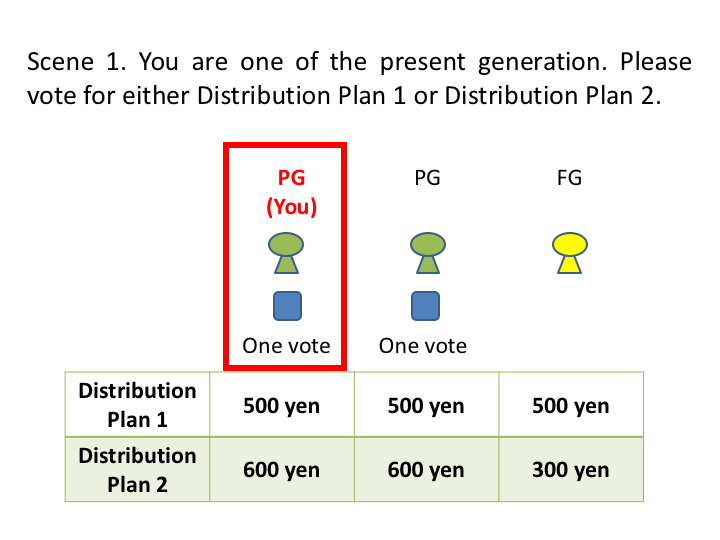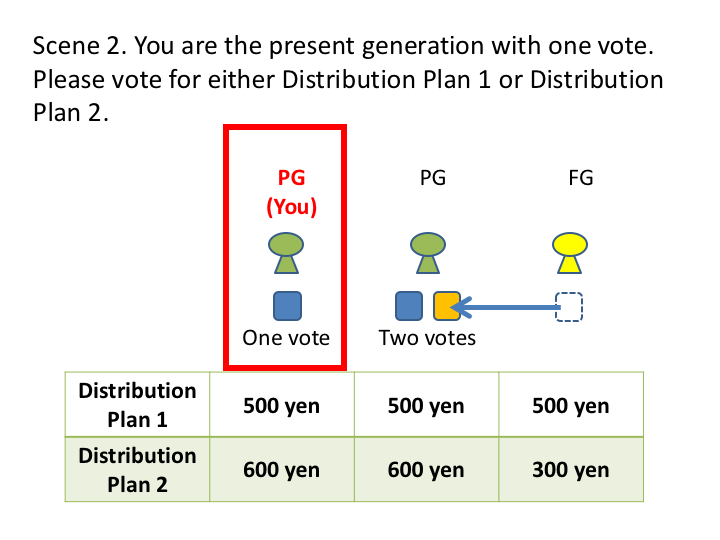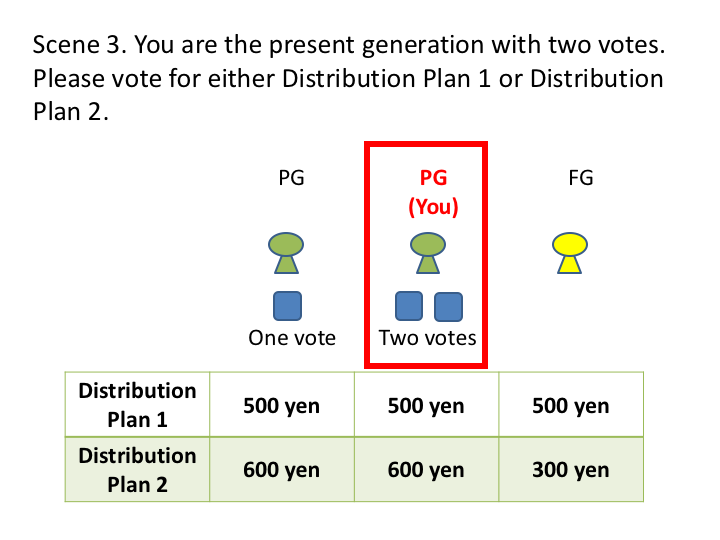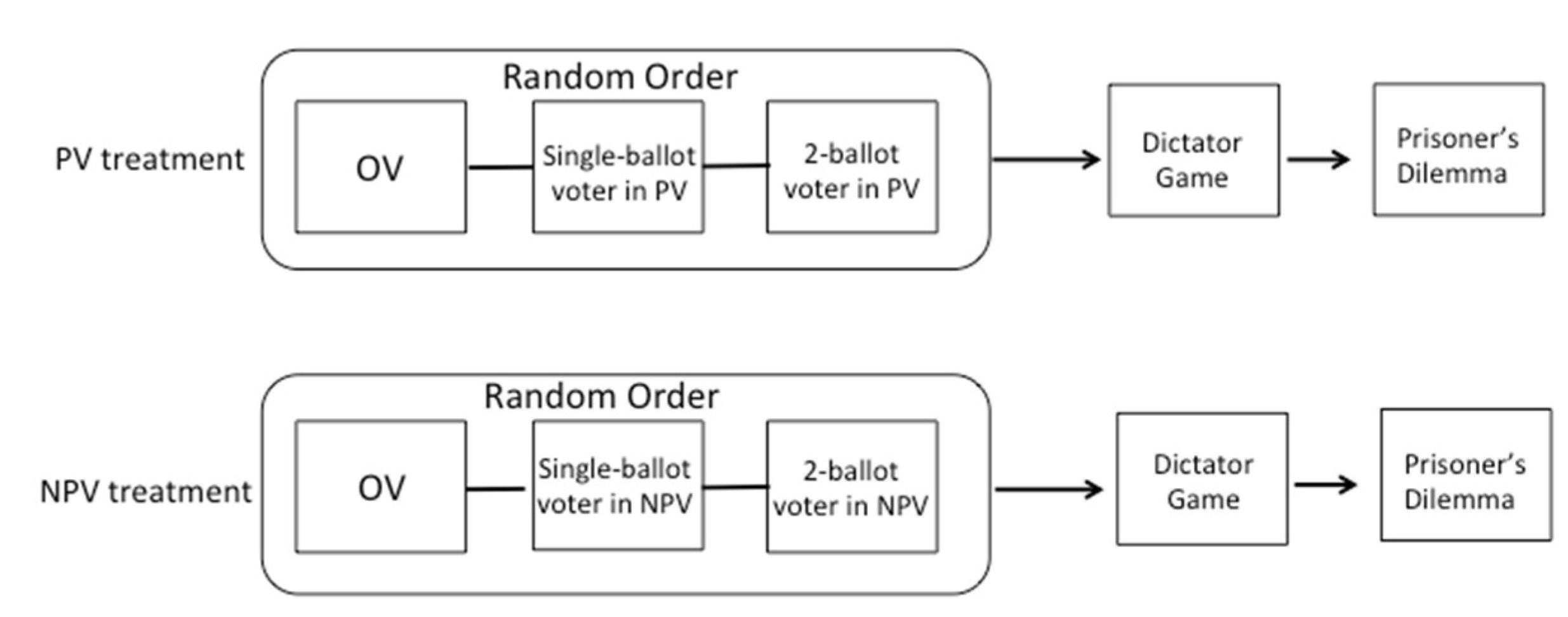Voting on Behalf of a Future Generation: A Laboratory Experiment
Abstract
1. Introduction
2. Material and Methods
2.1. Task
2.2. Two Types of Asymmetric Voting Scheme: Proxy Voting and Non-Proxy Voting
2.3. Hypothesis
2.3.1. Expressive Voting Preference
2.3.2. Bandwagon Preference
2.3.3. Summary of the Predictions and Their Presumptions
2.4. Experimental Design
2.5. Procedure
3. Results
3.1. Summary of Experimental Data
3.2. Checking the Presumptions
3.3. The Effect of the Asymmetric Voting Power: OV vs. NPV
3.4. The Effect of the Explanation about the Second Vote: NPV vs. PV
4. Discussion
Author Contributions
Funding
Conflicts of Interest
Appendix A
Appendix A.1. Experiment 1 (PV Treatment)



Appendix A.2. Experiment 1 (NPV Treatment)



Appendix A.3. Experiment 2
Appendix A.4. Experiment 3
- (1)
- You and your opponent make your decisions simultaneously,
- (2)
- You and your opponent make your decisions sequentially, with you being the first player,
- (3)
- You and your opponent make your decisions sequentially, with you being the second player and observing your opponent deciding to “Pass 200 yen”, and
- (4)
- You and your opponent make your decisions sequentially, with you being the second player and observing your opponent deciding “do not pass it”.
References
- Preston, S.H. Children and the elderly: Divergent paths for America’s dependents. Demogr 1984, 21, 435–457. [Google Scholar] [CrossRef]
- MacManus, S.A. Taxing and spending: a generational perspective. J. Pol. 1995, 75, 607–629. [Google Scholar] [CrossRef]
- Poterba, J.M. Demographic change, intergenerational linkages, and public education. Am. Econ. Rev. 1998, 88, 315–320. [Google Scholar]
- McDonald, M.D.; Budge, I. Elections, Parties, Democracy: Conferring the Median Mandate; Oxford University Press: Oxford, UK, 2005. [Google Scholar]
- Disney, R. Population ageing and the size of the welfare state: Is there a puzzle to explain? Eur. J. Pol. Econ. 2007, 23, 542–553. [Google Scholar] [CrossRef]
- Demeny, P. Pronatalist polices in low-fertility countries: Patterns, performance, and prospects. Popul. Dev. Rev. 1986, 12, 335–358. [Google Scholar] [CrossRef]
- Sanderson, W.C.; Scherbov, S. A near electoral majority of pensioners: Prospects and policies. Popul. Dev. Rev. 2007, 33, 543–554. [Google Scholar] [CrossRef]
- Aoki, R.; Vaithianathan, R. Is Demeny Voting the Answer to Low Fertility in Japan? Discussion Paper; Center of Intergenerational Studies, Hitotsubashi University: Tokyo, Japan, 2009. [Google Scholar]
- Vaithianathan, R.; Aoki, R.; Sbai, E. Support for Franchise Extension for Children: Evidence on Japanese Attitude to Demeny Voting; Technical Report; Hitosubashi University: Tokyo, Japan, 2013; Available online: http://hermes-ir.lib.hit-u.ac.jp/rs/bitstream/10086/26002/1/DP610.pdf (accessed on 2 July 2019).
- Corak, M. Public Policies for Equality and Social Mobility in Canada. Background Paper of Canada 2020. Available online: https://kingston.liberal.ca/wp-content/uploads/sites/61/2013/11/policiesequalitymobilityCanada-milesc.pdf (accessed on 2 July 2019).
- Thompson, D.F. Representing future generations: Political presentism and democratic trusteeship. Crit. Rev. Int. Soc. Pol. Philos. 2010, 13, 17–37. [Google Scholar] [CrossRef]
- Saijo, T. Future Design. In Future of Economic Design: The Continuing Development of a Field as Envisioned by Its Researchers; Laslier, M., Sanver, Z., Eds.; Springer: Berlin, Germany, 2019. [Google Scholar]
- Van Parijs, P. The disfranchisement of the elderly, and other attempts to secure intergenerational justice. Philos. Public Aff. 1998, 27, 292–333. [Google Scholar] [CrossRef]
- Wolf, S.; Goldschmidt, N.; Petersen, T. Votes on behalf of children: A legitimate way of giving them a voice in politics. Constitut. Pol. Econ. 2015, 26, 356–374. [Google Scholar] [CrossRef]
- Brennan, G.; Lomasky, L. Democracy and Decision; Cambridge University Press: Cambridge, UK, 1993. [Google Scholar]
- Brennan, G.; Hamlin, A. Expressive voting and electoral equilibrium. Public Choice 1998, 95, 149–175. [Google Scholar] [CrossRef]
- Leibenstein, H. Bandwagon, snob, and Veblen effects in the theory of consumers’ demand. Quart. J. Econ. 1950, 64, 183–207. [Google Scholar] [CrossRef]
- Zech, C.E. Leibenstein’s bandwagon effect as applied to voting. Public Choice 1975, 21, 117–122. [Google Scholar] [CrossRef]
- Montero, M.; Sefton, M.; Zhang, P. Enlargement and the balance of power: An experimental study. Soc. Choice Welf. 2008, 30, 69–87. [Google Scholar] [CrossRef]
- Guerci, E.; Hanaki, N.; Watanabe, N.; Esposito, G.; Lu, X. A methodological note on a weighted voting experiment. Soc. Choice Welf. 2014, 43, 827–850. [Google Scholar] [CrossRef]
- Feddersen, T.; Gailmard, S.; Sandroni, A. Moral bias in large elections: Theory and experimental evidence. Am. Pol. Sci. Rev. 2009, 103, 175–192. [Google Scholar] [CrossRef]
- Shayo, M.; Harel, A. Non-consequentialist voting. J. Econ. Behav. Org. 2012, 81, 299–313. [Google Scholar] [CrossRef][Green Version]
- Kamenica, E.; Brad, L.E. Voters, dictators, and peons: Expressive voting and pivotality. Public Choice 2014, 159, 159–176. [Google Scholar] [CrossRef]
- Wildschut, T.; Insko, C.A. Explanations of interindividual-intergroup discontinuity: A review of the evidence. Eur. Rev. Soc. Psych. 2007, 18, 175–211. [Google Scholar] [CrossRef]
- Charness, G.; Sutter, M. Groups make better self-interested decisions. J. Econ. Perspect. 2012, 26, 157–176. [Google Scholar] [CrossRef]
- Kamijo, Y.; Komiya, A.; Mifune, N.; Saijo, T. Negotiating with the future: Incorporating imaginary future generations into negotiations. Sustain. Sci. 2017, 12, 409–420. [Google Scholar] [CrossRef]
- Fehr, E.; Schmidt, K.M. The economics of fairness, reciprocity and altruism—Experimental evidence and new theories. In Handbook of the Economics of Giving, Altruism and Reciprocity; Kolm, S.C., Ythier, J.M., Eds.; Elsevier: Amsterdam, The Netherlands, 2006; Volume 1, pp. 615–694. [Google Scholar]
- Riker, W.H.; Ordeshook, P.C. A theory of the calculus of voting. Am. Pol. Sci. Rev. 1968, 62, 25–43. [Google Scholar] [CrossRef]
- Brennan, G.; Buchanan, J. Voter choice: Evaluating political alternatives. Am. Behav. Sci. 1984, 28, 185–201. [Google Scholar] [CrossRef]
- Scheussler, A.A. A Logic of Expressive Choice; Princeton University Press: Princeton, NJ, USA, 2000. [Google Scholar]
- Hillman, A.L. Expressive behavior in economics and politics. Eur. J. Pol. Econ. 2010, 26, 403–418. [Google Scholar] [CrossRef]
- Wiese, R.; Jong-A-Pin, R. Expressive voting and political ideology in a laboratory democracy. Eur. J. Pol. Econ. 2017, 50, 54–74. [Google Scholar] [CrossRef]
- Robbett, A.; Matthews, H.P. Partisan bias and expressive voting. Eur. J. Pol. Econ. 2018, 157, 107–120. [Google Scholar] [CrossRef]
- McAllister, I.; Studlar, D.T. Bandwagon, underdog, or projection? Opinion polls and electoral choice in Britain, 1979–1987. J. Pol. 1991, 53, 720–741. [Google Scholar] [CrossRef]
- Tyran, J.R. Voting when money and moral conflict: An experimental test of expressive voting. J. Public Econ. 2004, 88, 1645–1664. [Google Scholar] [CrossRef]
- Fischbacher, U. z-Tree: Zurich toolbox for ready-made economic experiments. Exp. Econ. 2007, 10, 171–178. [Google Scholar] [CrossRef]
- Bohnet, I.; Frey, B.S. The sounds of silence in prisoner’s dilemma and dictator games. J. Econ. Behav. Org. 1999, 38, 43–57. [Google Scholar] [CrossRef]
- Brosig, J. Identifying cooperative behavior: Some experimental results in a prisoner’s dilemma game. J. Econ. Behav. Org. 2002, 47, 275–290. [Google Scholar] [CrossRef]
- Steposh, J.P.; Gallo, P.S., Jr. Asymmetry of payoff structure and cooperative behavior in the prisoner’s dilemma game. J. Confl. Resolut. 1973, 17, 321–333. [Google Scholar] [CrossRef]
- Beckenkamp, M.; Hennig-Schmidt, H.; Maier-Rigaud, F.P. Cooperation in Symmetric and Asymmetric Prisoner’s Dilemma Games. Available online: https://papers.ssrn.com/sol3/papers.cfm?abstract_id=968942 (accessed on 6 August 2019).
- Mifune, N.; Hizen, Y.; Kamijo, Y.; Okano, Y. Preemptive striking in individual and group conflict. PLoS ONE 2016, 11, e0154859. [Google Scholar] [CrossRef]
- Levitt, S.D.; List, J.A. What do laboratory experiments measuring social preferences reveal about real world? J. Econ. Perspect. 2007, 21, 153–174. [Google Scholar] [CrossRef]
- Falk, A.; Heckman, J.J. Lab experiments are a major source of knowledge in the social sciences. Science 2009, 326, 535–538. [Google Scholar] [CrossRef]
- Kamijo, Y.; Tamura, T.; Hizen, Y. Mother’s paradox: Proxy vote for children lowers parents’ altruism for future society. 2019; Manuscript in Preparation. [Google Scholar]


| Present Generation 1 | Present Generation 2 | Future Generation | |
|---|---|---|---|
| Choice A (sustainable or future-oriented option) | 500 JPY | 500 JPY | 500 JPY |
| Choice B (present-oriented option) | 600 JPY | 600 JPY | 300 JPY |
| Frequency of the Future-Oriented Voting (i.e., Voting for Choice A) | ||
|---|---|---|
| Asymmetric Voting Power | Proxy Vote | |
| Ordinary Voting (OV) vs. Non-Proxy Voting (NPV) | Proxy Voting (PV) vs. NPV | |
| Expressive voting preference model | E1. NPV > OV | E2. NPV > PV |
| Bandwagon preference model | B1. OV = NPV | B2. PV > NPV |
| Presumptions of the predictions |
| |
| Variables | PV Treatment | NPV Treatment | PV vs. NPV | ||
|---|---|---|---|---|---|
| Mean | Std. Dev. | Mean | Std. Dev. | p-Value | |
| (1) Choice in OV | 0.37 | 0.48 | 0.35 | 0.48 | 0.648 |
| (2) Choice of single-ballot voter in PV and NPV | 0.38 | 0.49 | 0.30 | 0.46 | 0.099 * |
| (3) Choice of two-ballot voter in PV (self) | 0.31 | 0.47 | - | - | - |
| (3) Choice of two-ballot voter in PV (proxy-vote) | 0.73 | 0.45 | - | - | - |
| (3) Choice of two-ballot voter in NPV | - | - | 0.31 | 0.46 | - |
| (3) Split vote of two-ballot voter in PV and NPV | 0.43 | 0.50 | 0.18 | 0.39 | |
| Order 1 [(1) ≥ (2) ≥ (3)] | 0.16 | 0.37 | 0.16 | 0.37 | 0.936 |
| Order 2 [(1) ≥ (3) ≥ (2)] | 0.12 | 0.33 | 0.18 | 0.38 | 0.186 |
| Order 3 [(2) ≥ (1) ≥ (3)] | 0.15 | 0.36 | 0.11 | 0.32 | 0.280 |
| Order 4 [(2) ≥ (3) ≥ (1)] | 0.16 | 0.37 | 0.14 | 0.35 | 0.578 |
| Order 5 [(3) ≥ (1) ≥ (2)] | 0.24 | 0.43 | 0.26 | 0.44 | 0.723 |
| Order 6 [(3) ≥ (2) ≥ (1)] | 0.16 | 0.37 | 0.16 | 0.37 | 0.936 |
| Choice in DG | 185.2 | 216.8 | 184.9 | 211.7 | 0.937 |
| Choice in Simultaneous PD | 0.20 | 0.40 | 0.18 | 0.39 | 0.730 |
| Choice in Sequential PD (First) | 0.30 | 0.46 | 0.29 | 0.45 | 0.891 |
| Choice in Sequential PD (Second after C) | 0.36 | 0.48 | 0.31 | 0.46 | 0.344 |
| Choice in Sequential PD (Second after D) | 0.02 | 0.16 | 0.01 | 0.11 | 0.423 |
| Male | 0.59 | 0.49 | 0.53 | 0.50 | 0.350 |
| Location (Take value 1 for Kansai and 0 for Kochi) | 0.43 | 0.50 | 0.43 | 0.50 | 0.884 |
| Choice of Single-Ballot Voter in PV and NPV | Model 1 | Model 2 | Model 3 | |||
|---|---|---|---|---|---|---|
| ME | Std. Err. | ME | Std. Err. | ME | Std. Err. | |
| PV Dummy | 0.122 ** | 0.060 | 0.120 ** | 0.060 | 0.103 * | 0.059 |
| Choice in OV | 0.655 ** | 0.050 | 0.654 *** | 0.050 | 0.650 *** | 0.052 |
| Choice in DG | 0.0004 *** | 0.0002 | 0.0004 *** | 0.0002 | 0.0003 * | 0.0002 |
| Choice in PD | - | - | - | - | 0.097 | 0.085 |
| Choice in Sequential PD (First Mover) | - | - | - | - | −0.075 | 0.072 |
| Choice in Sequential PD (Second Mover after C) | - | - | - | - | 0.242 *** | 0.077 |
| Choice in Sequential PD (Second Mover after D) | - | - | - | - | 0.100 | 0.131 |
| Control (Orders in voting experiment and Location) | Yes | Yes | Yes | |||
| Control (Gender) | No | Yes | Yes | |||
| Log Pseudo-likelihood | −118.1 | −118.1 | −111.8 | |||
| Pseudo R2 | 0.426 | 0.426 | 0.457 | |||
| Sample Size | 321 | 321 | 321 | |||
© 2019 by the authors. Licensee MDPI, Basel, Switzerland. This article is an open access article distributed under the terms and conditions of the Creative Commons Attribution (CC BY) license (http://creativecommons.org/licenses/by/4.0/).
Share and Cite
Kamijo, Y.; Hizen, Y.; Saijo, T.; Tamura, T. Voting on Behalf of a Future Generation: A Laboratory Experiment. Sustainability 2019, 11, 4271. https://doi.org/10.3390/su11164271
Kamijo Y, Hizen Y, Saijo T, Tamura T. Voting on Behalf of a Future Generation: A Laboratory Experiment. Sustainability. 2019; 11(16):4271. https://doi.org/10.3390/su11164271
Chicago/Turabian StyleKamijo, Yoshio, Yoichi Hizen, Tatsuyoshi Saijo, and Teruyuki Tamura. 2019. "Voting on Behalf of a Future Generation: A Laboratory Experiment" Sustainability 11, no. 16: 4271. https://doi.org/10.3390/su11164271
APA StyleKamijo, Y., Hizen, Y., Saijo, T., & Tamura, T. (2019). Voting on Behalf of a Future Generation: A Laboratory Experiment. Sustainability, 11(16), 4271. https://doi.org/10.3390/su11164271




